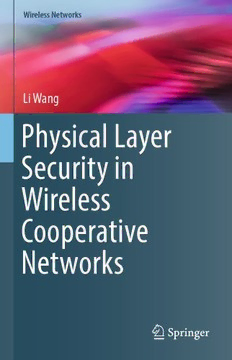Table Of ContentWireless Networks
Li Wang
Physical Layer
Security in
Wireless
Cooperative
Networks
Wireless Networks
Serieseditor
Xuemin(Sherman)Shen
UniversityofWaterloo,Waterloo,Ontario,Canada
Moreinformationaboutthisseriesathttp://www.springer.com/series/14180
Li Wang
Physical Layer Security
in Wireless Cooperative
Networks
123
LiWang
SchoolofElectronicEngineering
BeijingUniversityofPostsandTelecommunications
Beijing,China
ISSN2366-1186 ISSN2366-1445 (electronic)
WirelessNetworks
ISBN978-3-319-61862-3 ISBN978-3-319-61863-0 (eBook)
DOI10.1007/978-3-319-61863-0
LibraryofCongressControlNumber:2017948731
©SpringerInternationalPublishingAG2018
Thisworkissubjecttocopyright.AllrightsarereservedbythePublisher,whetherthewholeorpartof
thematerialisconcerned,specificallytherightsoftranslation,reprinting,reuseofillustrations,recitation,
broadcasting,reproductiononmicrofilmsorinanyotherphysicalway,andtransmissionorinformation
storageandretrieval,electronicadaptation,computersoftware,orbysimilarordissimilarmethodology
nowknownorhereafterdeveloped.
Theuseofgeneraldescriptivenames,registerednames,trademarks,servicemarks,etc.inthispublication
doesnotimply,evenintheabsenceofaspecificstatement,thatsuchnamesareexemptfromtherelevant
protectivelawsandregulationsandthereforefreeforgeneraluse.
Thepublisher,theauthorsandtheeditorsaresafetoassumethattheadviceandinformationinthisbook
arebelievedtobetrueandaccurateatthedateofpublication.Neitherthepublishernortheauthorsor
theeditorsgiveawarranty,expressorimplied,withrespecttothematerialcontainedhereinorforany
errorsoromissionsthatmayhavebeenmade.Thepublisherremainsneutralwithregardtojurisdictional
claimsinpublishedmapsandinstitutionalaffiliations.
Printedonacid-freepaper
ThisSpringerimprintispublishedbySpringerNature
TheregisteredcompanyisSpringerInternationalPublishingAG
Theregisteredcompanyaddressis:Gewerbestrasse11,6330Cham,Switzerland
Tomyfamily,friends,andstudents
-LiWang
Acknowledgments
Theauthor sincerelyacknowledges thesupportfromtheNationalNaturalScience
Foundation of China under Grant No. 61571056, the open research fund of the
National Mobile Communications Research Laboratory of Southeast University
(China)underGrant2016D04.
SpecialthankstoProf.ShermanShenwhomadethisbookpossible.Theauthor
would like to express her deepest gratitude to Prof. Gordon L. Stüber of Georgia
InstituteofTechnology(Gatech),Prof.ZhuHanoftheUniversityofHouston(UH),
andProf.BingliJiaoofPekingUniversityfortheiradviceduringthewritingofthis
monograph.
The author would also like to express appreciation to graduate students
Ruoguang Li, Qing Wei, and Yutong Ai of Beijing University of Posts and Tele-
communications(BUPT),andYingyangChenofPekingUniversityfortheirstrong
supportduringthepreparationofthismonograph.
vii
Contents
1 Introduction .................................................................. 1
1.1 BasicsofPhysicalLayerSecurity...................................... 1
1.1.1 ConceptandEvolutionofPhysicalLayerSecurity ........... 1
1.1.2 TheRelationshipBetweenCryptographyandPhysical
LayerSecurity .................................................. 6
1.1.3 ClassificationofAttacksinPhysicalLayerSecurity.......... 8
1.1.4 PerformanceMetricsinPhysicalLayerSecurity.............. 8
1.2 OverviewofWirelessCooperativeNetworks ......................... 13
1.2.1 ClassificationofWirelessCooperativeNetworks............. 13
1.2.2 ApplicationsofWirelessCooperativeNetworks.............. 17
1.3 WirelessCooperationforPhysicalLayerSecurityEnhancement .... 22
1.3.1 Multi-AntennaCooperation.................................... 22
1.3.2 Multi-UserCooperation........................................ 26
1.4 OutlineoftheBook..................................................... 32
References..................................................................... 33
2 ExistingTechniquesinPhysicalLayerSecurity.......................... 39
2.1 TimeReversalTechnique............................................... 40
2.1.1 BasicPrinciplesofTimeReversalTechnique................. 40
2.1.2 ApplicationsofTimeReversalTechnique..................... 43
2.1.3 TimeReversalTechniqueforPhysicalLayerSecurity........ 44
2.2 SpatialModulationTechnique.......................................... 45
2.2.1 BasicPrinciplesofSpatialModulation........................ 45
2.2.2 ExtendedVersions:SpaceShiftKeyingandGeneral
SpaceShiftKeying ............................................. 49
2.2.3 Pre-CodingAidedSpatialModulationSchemes.............. 51
2.2.4 SpatialModulationinPhysicalLayerSecurity................ 54
ix
x Contents
2.3 D2DCommunicationsinCellularNetworks .......................... 55
2.3.1 BasicPrinciplesofD2DCommunications .................... 55
2.3.2 Applications of D2D Communications in Future
5GNetworks.................................................... 58
2.3.3 SocialNetworks-AssistedD2DCommunications ............ 61
2.3.4 PhysicalLayerSecurityinD2DCommunications............ 64
2.4 ChapterSummary....................................................... 65
References..................................................................... 65
3 SecrecyAnalysiswithTime-ReversalTechniqueinDistributed
TransmissionSystem ........................................................ 71
3.1 SystemModel........................................................... 71
3.1.1 DistributedTimeReversalTransmission...................... 73
3.1.2 DirectTransmissionandDistributedBeamforming
Transmission.................................................... 77
3.2 BasicSNRAnalysisforSecurityEnhancement....................... 80
3.3 SNRAnalysiswithFixedMulti-PathDelay........................... 81
3.3.1 SNRAnalysisofDistributedTimeReversalTransmission... 81
3.3.2 SNRAnalysisofDirectTransmission......................... 84
3.3.3 SNRAnalysisofDistributedBeamformingTransmission ... 85
3.4 SNRAnalysiswithRandomMulti-PathDelay........................ 87
3.4.1 SNRAnalysisofDistributedTimeReversalTransmission... 87
3.4.2 SNRAnalysisofDirectTransmission......................... 89
3.4.3 SNRAnalysisofDistributedBeamformingTransmission ... 89
3.5 SimulationandNumericalResults..................................... 91
3.5.1 FixedNumberL ofMulti-PathComponents................. 91
k
3.5.2 RandomNumberL ofMulti-PathComponents.............. 95
k
3.6 ChapterSummary....................................................... 103
References..................................................................... 104
4 SpatialModulationinPhysicalLayerSecurity........................... 107
4.1 SecrecyEnhancementwithArtificialNoiseinSpatialModulation .. 107
4.1.1 SystemModelandProblemDescription ...................... 107
4.1.2 SecrecyRateAnalysis.......................................... 110
4.1.3 SimulationandNumericalResults............................. 112
4.2 Secrecy Analysis in Space Shift Keying (SSK) and
GeneralizedSpaceShiftKeying(GSSK)Modulation ................ 114
4.2.1 SystemModelandProblemDescription ...................... 116
4.2.2 SecrecyRateAnalysis.......................................... 117
4.2.3 SimulationandNumericalResults............................. 119
4.3 SecrecyAnalysiswithTransmitterPrecodingAidedSpatial
Modulation .............................................................. 121
4.3.1 SystemModelandProblemDescription ...................... 123
4.3.2 PrecodingMatrixDesign....................................... 124
Contents xi
4.3.3 SecrecyPerformancewithDetectionAlgorithm.............. 127
4.3.4 SimulationandNumericalResults............................. 129
4.4 ChapterSummary....................................................... 133
References..................................................................... 134
5 CooperativeSecurityinD2DCommunications .......................... 137
5.1 BackgroundandMotivations........................................... 138
5.1.1 SystemModelandAssumptions............................... 139
5.1.2 ChannelStateInformation ..................................... 140
5.2 SocialCharacteristicsforCooperativeCommunications ............. 141
5.2.1 SocialInteractionforContentSharing......................... 141
5.2.2 SocialTrustforCooperativeJamming......................... 142
5.2.3 ObjectiveProblemFormulation................................ 143
5.3 OptimizationforSecrecyRateMaximization......................... 144
5.3.1 SecrecyRateMaximizationwithFullCSI .................... 144
5.3.2 SecrecyRateMaximizationwithStatisticalCSI.............. 148
5.3.3 One-DimensionalSearchwithLowComplexity.............. 151
5.3.4 SimulationandNumericalResults............................. 153
5.4 TheSocialInteractionCaseforJammerSelection.................... 162
5.4.1 OptimalJammerSelectionwithFullCSI ..................... 162
5.4.2 OptimalJammerSelectionwithPartialCSI................... 166
5.4.3 OneDimensionalSearchwithLowComplexity.............. 169
5.4.4 SimulationandNumericalResults............................. 171
5.5 ChapterSummary....................................................... 175
References..................................................................... 176
6 Summary...................................................................... 179

